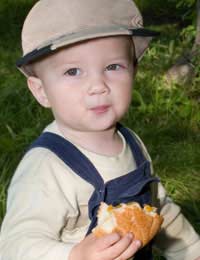Hidden Allergy Dangers in Kids Foods

Having a child with a food allergy can be very worrying. You’ve seen your doctor and discovered exactly what the allergy is and you’re being careful to avoid giving the dangerous trigger food. But the allergic reaction keeps happening. So what’s going on?
The problem could be that many common allergy triggers can be hidden in many of the meals and food products we eat every day. It’s also true to say, that some of the foods mums and dads most frequently give to children can be the main offenders.
Hidden Dairy Products in Food
Let’s look at the problems encountered by the dairy detective. If your child has a dairy allergy, you have obviously stopped giving them any kind of milk, cheese or yoghurt. But that’s just the start of it. You’ll also need to be on the lookout for a whole host of ingredients that have probably never crossed your mind before – things like whey, casein and caseinate. They’re all derived from milk and can turn up in the most unlikely places! For example, if your child is happy to eat a pork chop, but reacts badly to a pork sausage, it could well be that the processed sausage meat contains a hidden milk product.When it comes to childhood favourites chocolate and cheese, Soya versions can be good alternatives for the dairy allergic child, but always read the labels, as you might find casein lurking in some brands. The crucial thing is to look at labels and learn all the different names for milk derivatives. Here are some to make a note of, but talk to your doctor or allergy specialist for a complete list, relevant to your child.
- Ammonium/calcium/magnesium/potassium/sodium caseinate
- Casein/caseinate/rennet casein
- Curds
- Delactosed/demineralised whey
- Hydrolysed casein
- Lactalbumin/lactalbumin phosphate
- Lactate
- Lactose
- Lactoferrin
- Lactoglobulin
- Whey
- Whey protein concentrate
Hidden Soya in Common Foods
If your child is allergic to Soya, you’ll encounter many of the same problems. In fact, it seems Soya can hide in even more food products than milk! Because Soya in its natural state is almost flavour free, it’s a very versatile addition to many types of processed foods. So, while you might think it’s fairly easy to avoid very obvious Soya products like soy sauce and tofu (not the average child’s favourites anyway!), you’ll need to be more vigilant when giving your child any kind of processed food.From a milk shake to a slice of bread, and from a pizza to an ice cream, Soya is a common ingredient of many ingredients on your supermarket shelf. There are two ways to tackle this. The first is to read, read, read the labels. The second is to limit as much as possible your child’s intake of processed foods. If you’re cooking from scratch, you can be certain that the potatoes, carrots and organic chicken you’re serving up contain no Soya. But if you choose to give your child oven chips, tinned spaghetti and chicken burger, you might find you’re dishing up a tasty meal laced with hidden Soya.
Hidden Wheat in Foods
It’s tedious, but true, that if your child has an allergy to wheat, you’re also going to become a label detective. For a truly wheat-free diet you’ll need to check all ingredient labels, even on the most unlikely foods. There is hidden wheat in many convenience products, like ready meals and sauces, and traces of wheat are sometimes found in herbs and spices.But on the positive side, many supermarkets and health food shops now stock wheat-free ranges of many child-friendly favourites like biscuits, cakes and breakfast cereals. This has broadened the choice for many wheat-allergic children. Look out for wheat-free flour if you’re making a birthday cake!
Hidden Nut Allergy Triggers in Food
Most parents are aware of the labelling regarding nuts and food. Always look out for advice on whether a product contains, or may contain, nuts. Obvious potential offenders are cakes, biscuits and cereal bars, but products such as bread and confectionary might have come from factories where peanuts are also used, and it’s possible tiny traces of nut allergen might remain on otherwise acceptable foods. So, read the label and if you’re not sure, don’t let your child eat it.Surprisingly perhaps, children who are allergic to peanuts are usually fine with peanut oil. That’s because it’s been refined, and the protein, which causes allergic reactions has been removed. But unrefined peanut oils can cause a reaction, so if in doubt, leave it out, and discuss any concerns with your doctor or allergy specialist.








